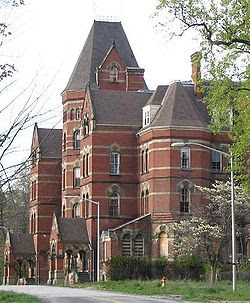Friday, October 30, 2009
Saturday, October 24, 2009
19th Century Prostitution
Assignment: Free write for about fifteen minutes (using a computer on either a word doc or blog entry) on what your conceptions of womanhood during the Victorian era are and how Whitman would have been accepting or critical of the prostitute. Do some further online research (because the internet is fast and convenient!) on the gender roles during the 19th century, the links above are only a start- consider how women lived in both the "angel in the house" world and the brothel world. What was the typical upbringing of a woman who ended up in either situation? How might womanhood and the controversial issue of prostitution be relevant today?
15 minute Pseudo Free Write:
Evidently prostitution in the 19th century was extremely common and occurred on various levels. 1 woman in 36 people were prostitutes or 1 woman per 12 adult males. Some prostitutes emerged from low economic backgrounds and used their bodies as ways to support themselves financially. This is not too different from today's prostitution. Often these women were either orphans or 1/2 orphans where their families could not support them. They were not entirely a lost cause: there was much effort put forth to restore these "fallen women" and some even ended up marrying former clients--an obvious afterlife is seen in the movie, Pretty Woman.
Two examples of the different types of prostitution are courtesans and street walkers.
Courtesans were mistresses kept by men who were of the bourgeoisie or nobility and chose this life style for the sake of freedom and guaranteed luxury. This type of prostitution was designated high class and also referred to as an escort. This woman might stick to a few long term clients rather than high quantity clientele.
Street walkers either walk the streets or work in the brothels. The commonality of these kinds of sex workers increased the spread of Venereal Disease, gonorrhea, and syphilis. There was even a Contagious Disease Act passed in 1866 which required prostitutes to pass pelvic examinations in order to combat the spread of these diseases. The men were never required to be examined because that was considered demeaning.
Friday, October 9, 2009
Assignment: 19th Century Madness and Walt Whitman.
The next three class periods will be spent discussing Walt Whitman's "Song of Myself" in conjunction with the cultural context of madness and the insane asylum in the latter half of the 19th century.
One week prior to "Class 1" chapter 2: "The Great Confinement" and chapter 3: "The Insane" of Madness and Civilization are handed out. They are to be read at home and students ought to be prepared to discuss them. Chapter 2 discusses the progression of the mental institution while chapter 3 looks closely at how insanity is articulated. We will spend "Class 1" discussing Foucault's representation of madness and how he explores the transition of madness from the Renaissance to the 19th century.
Students will come to "Class 2" having read and thought about Walt Whitman's "Song of Myself" specifically focusing on the notion of the asylum, mental patients, and madness and must be prepared to discuss the poem. Class discussion will focus on what madness is and how it is represented in Whitman's work. We will pay particular attention to actual 19th century asylums.
"Class 3" will follow up the discussions of each of the former class periods while exploring some of the various ways Whitman's contemporaries portray madness. Short excerpts and poems will be read in class each with the intention of building additional context for 19th century madness.
Writing Assignment (prompt handed out in "Class 3"):
What is madness and how was this explored by authors, poets, and writers in the 19th century? How has institutionalizing madness and the popularity of the insane asylum contributed to the artist, poet, author, philosopher's representation of it? Pick any two authors, artists, poets, or philosophers and compare and contrast their ideas of madness as they portray it in a single passage, painting, poem or otherwise with Walt Whitman's notion of madness and the asylum in "Song of Myself".
The assignment will be posted to your individual blogs and will be judged based on persuasive, thoughtful, and innovative connections between the materials you choose and those discussed in all three class periods. Please include the passage or the artistic representation of madness that you choose to analyze as well as a specific Whitman passage in your post. Please don't be concerned with the length of your blog because pictures of insanity can speak a thousand words and you are encouraged to use any form of artistic medium to display 19th century madness. Just be sure to make solid connections and analyze those connections clearly and concisely.
Tuesday, October 6, 2009
19th Century Asylums Culturally Objectified
In Walt Whitman's "Leaves of Grass" a collection of poems first published in 1855, the cultural status of the "lunatic asylum" peaked my interest. The following lines are two direct references to psychiatric hospitals or asylums:
"I saw the face of the most smeared and slobbering idiot they had at the asylum,"
I decided to look into the status of mental institutions in the 19th Century to see what kind of framework Whitman was working with. There were quite a few resources to choose from, though I chose to focus on Whitman's very own backyard of New York.
Kirkbride Buildings shot up all over the East Coast in the latter half of the 19th Century with generally the same floor plan for each building: "Once state-of-the-art mental healthcare facilities, Kirkbride buildings have long been relics of an obsolete therapeutic method known as Moral Treatment. In the latter half of the 19th century, these massive structures were conceived as ideal sanctuaries for the mentally ill and as an active participent in their recovery. Careful attention was given to every detail of their design to promote a healthy environment and convey a sense of respectable decorum. Placed in secluded areas within expansive grounds, many of these insane asylums seemed almost palace-like from the outside. But growing populations and insufficient funding led to unfortunate conditions, spoiling their idealistic promise."

Buffalo State Hospital: Buffalo, NY. Began in 1871 and finished in 1895.
Hudson River State Hospital for the Insane: Poughkeepsie, NY. Completed in 1871.

Utica State Hospital: Utica, NY. Yet, from its earliest days, Utica was overcrowded and underfunded. In 1843, the average daily population was 109 with a 49 percent recovery rate; by 1869 the population was 600, the recovery rate had dropped to 26 percent, and seven times as many insane persons were still in poorhouses. Although advocates of Brigham's "moral treatment" philosophy were hard pressed to admit that some cases were beyond their reach, a growing number of physicians and legislators began to see a separate category for the chronic insane; these patients were incurable, they argued, and they needed only custodial care.

Asylum on Blackwell's Island: New York City, NY. Established in 1839. "This asylum was part of a complex that included a penitentiary, an alms house, a smallpox hospital, and other institutions. At times, inmates from the penitentiary supervised the patients in the asylum."

New York City, NY. Established in 1808, location of former grounds: Columbia University, Morningside Heights. Isn't that insane??
All this to say, Walt Whitman was born on Long Island and grew up in and around New York. Lunatic Asylums appear in his writing because he was surrounded by them. This cultural context is very interesting and sheds light on a whole different aspect of "Song of Myself." These psychiatric hospitals sprang up throughout the 19th Century increasingly so in the latter half of the 1800's.
Subscribe to:
Comments (Atom)

